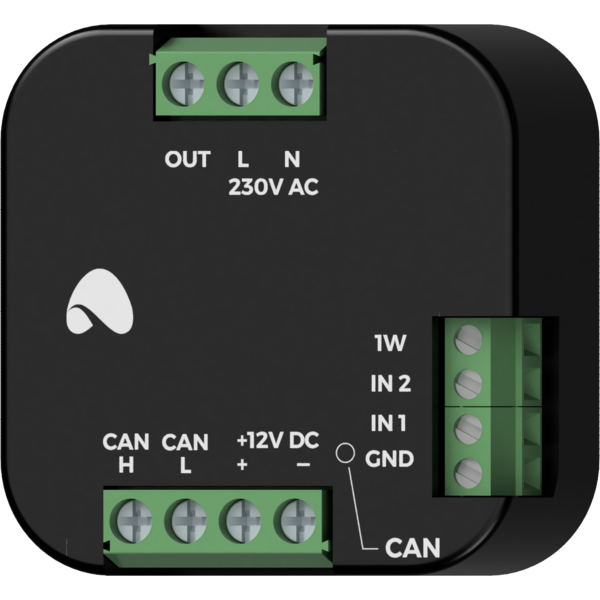
The image above is for illustration purpose only. The actual module may vary from the one presented here.
Module M-DIM-1p is a component of the Ampio system. Required voltage to power the module is 11 — 16V DC. The module is controlled via CAN bus.
The module has one dimmable output, two ground detecting inputs and a 1-Wire interface.
The module outputs are not intended for controlling sockets due to the possibility of connecting a receiver that exceeds the module’s capabilities.
With the use of the module, it is possible to control the light intensity of incandescent bulbs, halogens, dimmable LED bulbs and dimmable CFL fluorescent lamps. It is also possible to control light sources powered through a transformer.
Light sources powered through a transformer
In the case of controlling light sources powered through a transformer, the device must be configured to disconnect the power supply when detecting a trailing edge.
The maximum power of a receiver connected to the dimmable output is 300W. Input voltage ranging from 48V AC to 250V AC can be smoothly regulated.
Dimmable outputs have short-circuit, overload and thermal protection. The module facilitates power measurement.
The module has inputs that go into the active state when they are shorted to ground. They can be used in the case of any devices with potential-free contact outputs, e.g. wall switches, reed switches, buttons, switches, etc. They can also be used for integration with devices with potential-free relay outputs or optocoupler outputs with a collector voltage greater than 12V.
The module is equipped with a 1-Wire interface connector that allows to connect up to 6 digital Dallas DS18B20 temperature sensors. The temperature measurement result is available for all devices operating within the building automation bus. It may turn out to be particularly useful for purposes related to temperature regulation, or to present the measurement result on touch panels and in a mobile application.
The total length of the 1-Wire bus cable to which the temperature sensors are connected cannot exceed 15m.
The dimensions of the module enable its installation in a standard junction box. In order to start the module, it must be connected to the CAN bus. The bus of the Ampio system consists of four wires - two for power and two for communication between the modules.
In addition to the CAN bus connector, the device has a mains voltage connector and a dimmable output, as well as a connector for ground detecting inputs and a 1-Wire interface.
On the front of the module there are signalling LED indicators. The redl LED with the label CAN indicates the status of communication on the CAN bus:
The module is programmed with the use of the Ampio Designer software. It allows you to modify the parameters of the module and define its behaviour in response to signals directly available to the module as well as general information coming from all devices present in the home automation bus.
Dimensions expressed in millimeters.
Click to enlarge and open in a new tab.